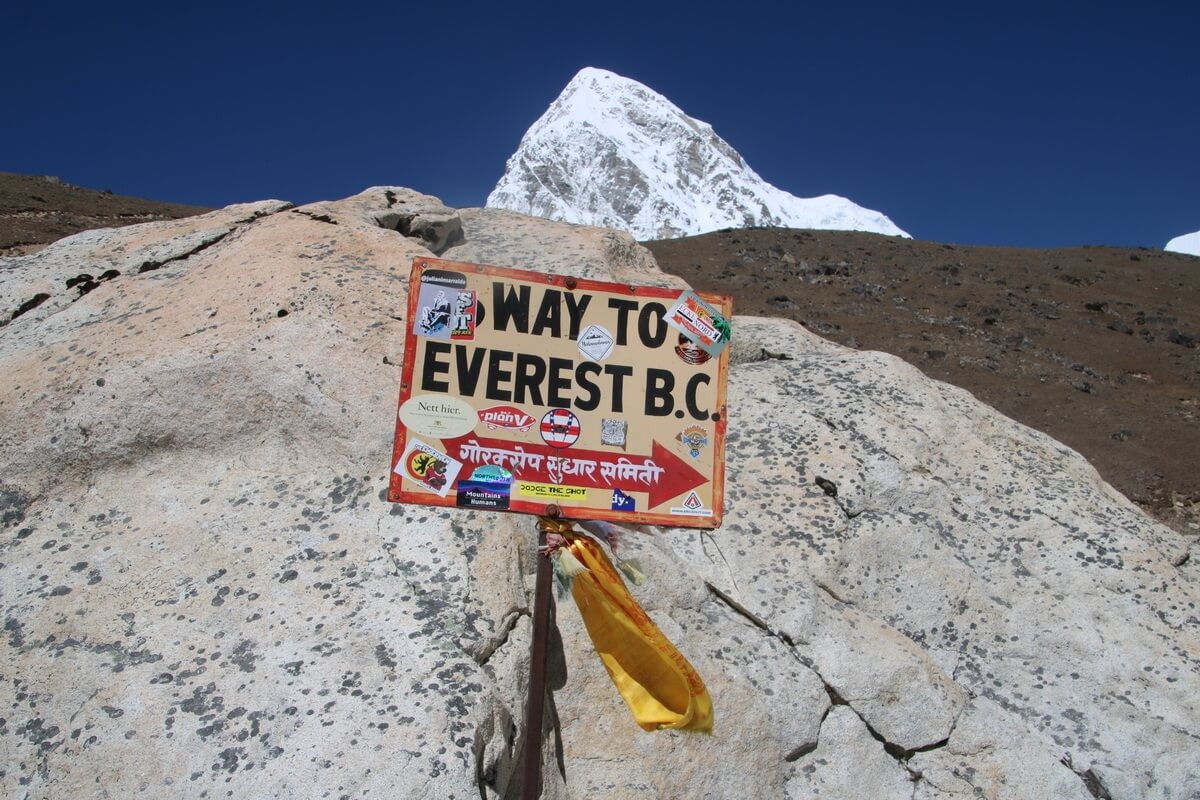

Everest Base Camp in luxury and comfort – folly or just overpriced?
The Everest Base Camp trek is a once-in-a-lifetime journey through Sherpa villages to Everest’s base. But in 2025, the Independent’s (UK newspaper) “Flat whites and underfloor heating” peddles a £11,875 ($15,000) group trek that’s more cash grab than Himalayan quest. With promises of coffee at 4,000m and too many helicopters, it skips trekking insurance and shackles you to group chaos.
I don’t do it often, but I really grated my teeth when I read the article. On so many levels. Junkets, paid-ops, or sheer advertising promotion. Years ago people in the industry said, just let it slide. It’s 2025 and nope, it’s not going to fly any more. It’s one thing paying for luxury on a trek, it’s another to avoid the important details and charge way over the top for the privilege. There’s a huge difference paying for a group luxury trek as they did, or pay for a private trek luxury trek that’s custom made for you which costs less and offers so much more.
Whether you’re budgeting or chasing luxury, I’ll show why it’s a rip-off compared to a private luxury trek ($6,657), average trek ($1,677), or a no-porter budget option ($1,513), using 2025 prices. Namche Bazaar’s espresso machines aren’t new; no porter should haul new espresso machines either. Plan better with a trusted trekking guide or go it alone with an EBC guide. Let’s find the “best price for the Everest Base Camp trek” and keep it real.
Debunking the Independent’s Overpriced Group Trek
The Independent’s piece reads like a glossy ad for The Ultimate Travel Company’s 14-day group trek with Mountain Lodges of Nepal, costing $15,000. It dangles luxuries but truly flops against a custom local private luxury trek ($6,657, 14 days), an average private trek ($1,677, 12 days), or a no-porter trek ($1,513, 12 days). Keeping it real—hot showers vanish above Dingboche (4,410m), leaving you with icy buckets at Gorak Shep (5,164m), per my DIY EBC guide. Yep, you can buy a bottle of hot water for your bucket or, like most, stick to a bucket and wipe down. Namche’s underfloor heating is standard in a few plush hotels and by no means a $15,000 flex. Meanwhile, “premium tents” at EBC (5,364m) are just overpriced sleeping bags. The flat-white nonsense is peak absurdity. Namche’s cafes have had $3–$5 espressos for over a decade. Coffee at EBC? That’s porters hauling an espresso machine (plus a generator to run it), which my “Find the best price for the EBC trek” wisely suggests swapping for an AeroPress.

Have Everest Base Camp Treks Gone Insanely Expensive?
Including international flights in the group luxury trek? That’s a head-scratcher. For $1,250 on average for a London-to-Kathmandu flight, you could spend an extra $100 for Emirates’ plush seats. Either way, booking your own flight with the perks you want is a no-brainer. Let a travel agency book your international flight, and you’ll likely paying double or triple for the same thing. Your choice.
The $15,000 tour includes two helicopter flights ($1,000–$2,000 each). Personally, it reads like ditching the descent and trashing the environment, unlike a private trek’s single optional chopper. Keep in mind, helicopters got axed at Annapurna Base Camp for noise, avalanche risks, chewed-up trails, and spooked yaks. EBC locals tried a 2025 ban to save teahouse jobs and paths but got steamrolled by big tour outfits (cough, let’s not reread the first paragraph). Group treks, as “Why you should avoid group trekking tours in Nepal” points out, mean rigid schedules—no Sherpa village stops—and group bickering. Extras like showers/Wi-Fi ($65 for lodge perks) and transport ($10 for Ramechhap bus) aren’t included, adding ~$225 with optional tips. The $15,000 also skips ~$150-200 for trekking insurance, a must for EBC treks. This trek’s peddling pure marketing, not mountain magic.

Why Custom Private Luxury Treks Outshine Group Treks
They don’t ring off the tongue. But, if you want plush digs without group drama, a custom-made private luxury trek ($6,657, 14 days) crushes the Independent’s $15,000 flop. On a budget? It’s easy to arrange a private trek ($1,677, 12 days) or a budget private trek with a no-porter option ($1,513, 12 days). Again, group treks’ fixed schedules cut out Namche’s Sherpa tea ceremonies, where locals spin mountain tales, or side trips to Gokyo Lakes; see my EBC guide. A private guide dishes one-to-one Sherpa climbing lore and sets your pace as you want, sparing you the luxury group’s slowest hiker. Costs are upfront, so no sneaky fees for showers or Wi-Fi, and local guides snag deals. Private treks let you connect with Sherpa culture, whether you’re splurging or on a budget.
What about those online budget treks to Everest for $800? I’ve written about this until I’m blue in the face. Avoid these too-good-to-be-true treks. Most are hyped marketing by tour operators who gather online buyers, wait until they arrive, then bundle them into a huge group. Complain, and you’ll get a last-minute excuse or sob story. Guilted or pressured into your new cheap tour, you set off with a myriad of others and settle for dorm rooms, watery food, and trekking companions who trek at the speed of a tortoise. Consider yourself lucky—you could have signed up for one of the trekking scam sites targeting your travel insurance more than your expectations.
Back to the topic at hand: the real cost of an Everest Base Camp trek, luxury or not. Let’s break it down.

Private Luxury Trek Costs in 2025
A local custom-made private luxury trek costs $6,657 for 14 days, under half the Independent’s price, with top-notch comfort. Here’s the local custom price breakdown so you can see the costs involved:
- Flights: $1,680, covering London to Kathmandu ($1,250, think Air China’s $1,200 or Emirates’ $1,300) and Kathmandu to Lukla return ($430, $215 each way).
- Accommodation: $1,830, with Kathmandu Plaza Hotel (3 nights, $180 at $60/night), high-end lodges like Everest View Hotel for epic views (9 nights, $1,350 at $150/night), and an EBC premium tent for Himalayan nights (2 nights, $300 at $150/night).
- Helicopter Transfer: $1,500 for EBC to Lukla, one flight to ease trail strain.
- Guide and Porter: $1,008, with a guide ($700 at $50/day) sharing Sherpa tales and a porter ($308 at $22/day) hauling gear.
- Permits: $60 for Sagarmatha National Park ($30) and Khumbu Pasang Lhamu Entry Fee ($30).
- Meals: $504 for full-board Dal Bhat ($12/meal, 3 meals/day), a Sherpa go-to.
- Extras: $75, with showers ($25 for 5 hot showers at lodges), charging ($30 for 3 camera charges at tea houses), and Wi-Fi ($20 for 10GB Everest Link card for emails).
- Total: $6,657 (£5,250/€5,794).
Add trekking insurance. Book via trusted guides.
Average EBC Trek Costs in 2025
Budget travelers hit EBC for $1,677 (with porter) or $1,513 (no porter) over 12 days, or can DIY their trek via “A full breakdown of an Everest Trek Cost”:
- Permits: $60 for Sagarmatha National Park ($30) and Khumbu Pasang Lhamu Entry Fee ($30).
- Flights: $430 for Kathmandu to Lukla return ($215 each way).
- Guide and Porter (With Porter): $624, with a guide ($360 at $30/day) and porter ($264 at $22/day). (No Porter): $360, guide only ($30/day).
- Accommodation: $60 for tea houses (12 nights at $5/night), basic but cozy.
- Meals: $432 for Dal Bhat ($12/meal, 3 meals/day).
- Water: $96 for 4 liters/day at $2 (free with filter).
- Extras: $75, with charging ($15 for 2 phone charges at tea houses) and transport ($10 for Ramechhap bus to Lukla flight). (No Porter: Same $75).
- Total: $1,677 (With Porter) or $1,513 (No Porter) (~£1,320/£1,190).
Add trekking insurance. Book via local guides.
Comparison Table
| Item | Independent Group ($15,000, 14 days) | Private Luxury ($6,657, 14 days) | Average Trek ($1,677, 12 days) | Average Trek (No Porter, $1,513, 12 days) |
|---|---|---|---|---|
| Flights (Int’l + Domestic) | Included (~$1,680) | $1,680 | $430 | $430 |
| Accommodation | Included (~$1,830) | $1,830 | $60 | $60 |
| Helicopter Transfer | Included (~$2,000) | $1,500 | $0 | $0 |
| Guide and Porter | Included (~$1,008) | $1,008 | $624 | $360 |
| Permits | Included ($60) | $60 | $60 | $60 |
| Meals | Included (~$504) | $504 | $432 | $432 |
| Showers/Wi-Fi* | Excluded (~$65) | $45 (Showers $25, Wi-Fi $20) | $0 | $0 |
| Charging* | Excluded (~$10) | $30 | $15 | $15 |
| Transport* | Excluded (~$10) | $0 | $10 | $10 |
| Total | $15,000 (plus ~$225 extras) | $6,657 | $1,677 | $1,513 |
*Footnote:
- Showers/Wi-Fi: $5 showers (e.g., Namche lodges), $20 Wi-Fi (10GB Everest Link card).
- Charging: $5–$10 phone/camera charges (e.g., tea houses).
- Transport: $10 Ramechhap bus for Lukla flight.
- Excluded tips for Independent Group ($150–$200 for guide/porter) add to extras.
Note: The Independent article didn’t specify if Wi-Fi, charging, or hot showers were included in the price. I assume they were. That’s still less than $100 in costs.
Sample Itinerary: Private Custom Luxury Trek
This local private luxury trek ($6,657, 14 days) offers a flexible EBC journey, far better than the Independent’s $15,000 group trek. Here’s an example of your route, bookable via trusted guides, or on a budget via my EBC guide, which leaves out the helicopter:
- Day 1: Fly Kathmandu to Lukla ($215), trek to Phakding (3–4 hours, 2,610m, $50 lodge).
- Day 2: Trek to Namche Bazaar (6 hours, 3,440m, $150 lodge).
- Day 3: Acclimatize in Namche, visit Sherpa Culture Museum, join a tea ceremony ($150 lodge).
- Day 4: Trek to Tengboche (5 hours, 3,860m), explore monastery rituals ($150 lodge).
- Day 5: Trek to Dingboche (6 hours, 4,410m, $150 lodge).
- Day 6: Acclimatize in Dingboche, optional hike for views ($150 lodge).
- Day 7: Trek to Lobuche (5 hours, 4,940m, $150 lodge).
- Day 8: Trek to Gorak Shep (5 hours, 5,164m), visit EBC (5,364m, $150 tent).
- Day 9: Helicopter to Lukla ($1,500, 30 minutes, $50 lodge).
- Day 10: Fly to Kathmandu ($215, $60 hotel).
- Day 11: Sightsee in Kathmandu, visit Boudhanath stupa ($60 hotel).
- Day 12: Depart Kathmandu.
Need to add a day? No problem. Don’t want a helicopter? No problem. Dietary requirements? Let me know. That’s why it’s a custom trek. It’s your trek, your way.

Budget Tips for Trekkers
Eat Dal Bhat ($6–$12/meal, cheaper and more filling than $10+ pizzas). Use a Steripen ($100) or water filtration tablets to filter water, saving $96 over bottled ($2–$5/liter), as per my EBC guide. Book with local guides for $1,400–$1,800 packages, and always get trekking insurance. Unlike the Independent’s trek, local trekking agents are far more flexible. To me, that’s the sign of real premium luxury. Private treks avoid group headaches, ideal for luxury or budget travelers. Looking for perks like all-in helicopters and hot showers? Read on.
So, you made it to EBC and want a helicopter back? It’s easy, but here’s the scoop. You can get a helicopter from EBC to Lukla and from Lukla to Kathmandu—two rides. No, there’s no direct EBC-to-Kathmandu chopper (not even the Independent managed that). Technically possible, but you’ll pay a fortune. Realistically, some folks shave off 2+ days by taking a chopper from EBC to Lukla, then a plane to Kathmandu. It’s costly. If time isn’t an issue, a custom luxury trek outperforms here if you’re prepared to wait. Shared helicopters from EBC are often available but unscheduled. You could nab a seat for $500 per person if available; otherwise, it’s double or triple for a regular fare. It’s one of the quirks of being at the top of the world—things aren’t scheduled, so they’re tough to book. Have a few days to spare, and you might snag a bargain ride back.
What about the road?! Can’t I save money by taking a bus to Surke? Actually, you’ll be going to Salleri by bus, and then it’s a private jeep to Surke followed by a few hours of trekking. Total cost over $300. With an average flight of $215 one-way to Lukla. You won’t be saving money, yet. I should also point out that it’s not at all comfortable on the jeep section right now. And, if it rains, be prepared to get out and push in knee high mud. I won’t go into details here, but all that will change very soon. For now, it’s best to take the bus/jeep combination option only in the case of the weather stopping all flights to Lukla and you are tight on time. Before anyone asked about cheap helicopters from Lukla to Kathmandu … yes, shared helicopters are possible. But you”ll need a trekking agent, a fist full of cash, trust, and patience. There are no scheduled helicopter flights for shared passengers. You literally need a spot to open to bag a bargain. There might be many people waiting, or none. A bidding on tickets often breaks out or lengthy waits for more people to show up. It’s certainly not a reliable option if you are on a budget. The road holds out some promise in the future. So stay turned here or on my dedicated on how to trek the Everest Base Camp trek.

Why Private EBC Treks Win in 2025/2026
The Everest Base Camp trek is about Sherpa hospitality and Everest’s raw power—not coffee hauled up mountains. The Independent’s $15,000 group trek inflates costs, skips trekking insurance, and harms trails with helicopters. A private luxury trek ($6,657) offers high-end lodges and a private guide, with $1,250 London flights and $430 domestic.
Meanwhile, budget treks ($1,677 with porter, $1,513 without) deliver the real EBC for less. Don’t believe it? Unlike sponsored websites, everything here is transparent. Prices are clear in my EBC guide and “EBC trek costings”. There will also be a feature podcast episode about luxury and normal costing Everest treks on Nepal: Uncovered. Available on Spotify, Apple Podcasts, and all platforms next week.
Want more info on trekking in Nepal? Never trekked before? Grab my guidebook “First Time Trekking in Nepal” ($4.99) to see what it’s all about. Or, if you’re set on going, get the full “Trekking in Nepal Guidebook” ($19.99), also available in paperback.
Trek EBC your way—private, sustainable, unforgettable.
Get My Trekking in Nepal Guidebook & Discover More Than Anyone Else!
Looking for more insider tips and information like this? Get the most up-to-date, popular, and dedicated guidebook to Trekking in Nepal in the world. Covering 29 full treks over 400 pages, it’s the only trekking guidebook with links showing how to combine treks! Available as an instant download or with worldwide shipping for the paperback edition.
Take a look below and find out why this beats all other guidebooks!
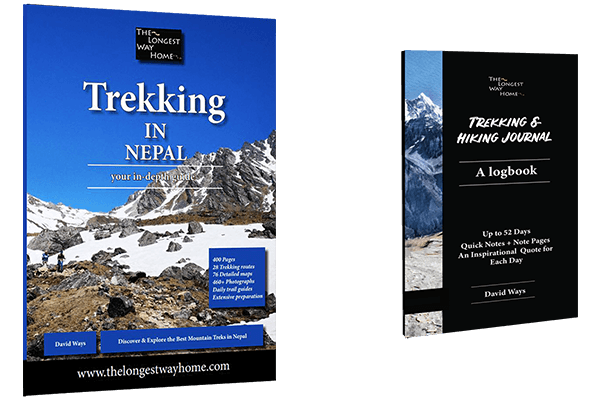
Get the Trekking in Nepal guidebook here!
Get the paperback Trekking & Hiking Journal here!
Or
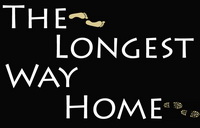
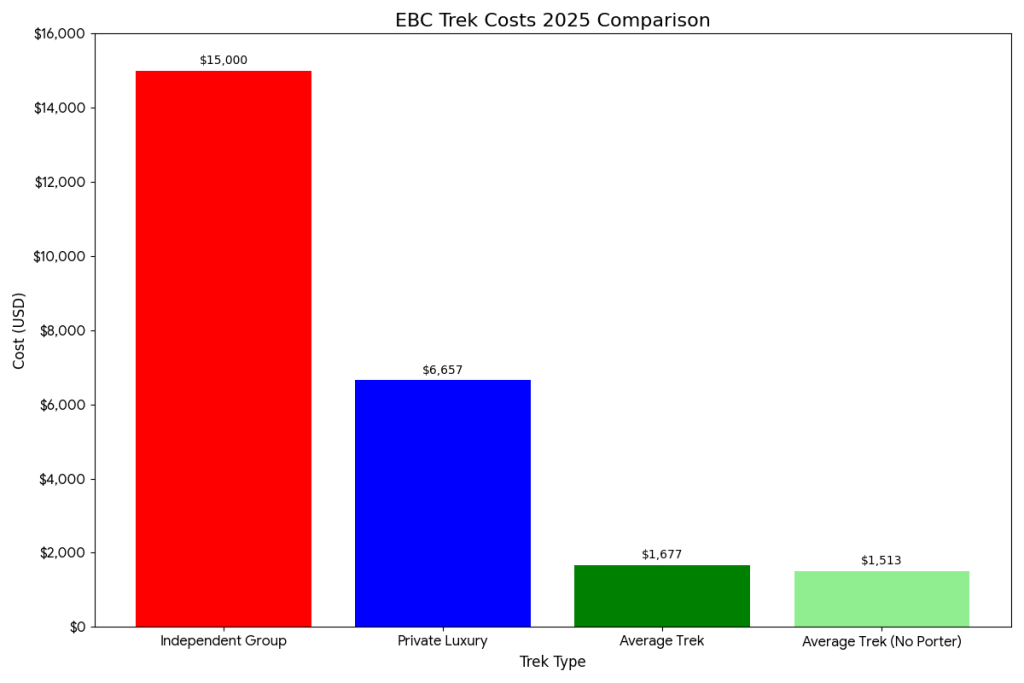
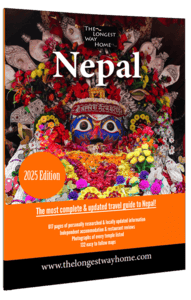
That’s a lot of profit for someone when you add it all up and compare it to other treks. Does the 6k option include accommodation? And if so, what type?
There is indeed a lot of profit in the $15,000 package – it’s one of the main issues I wrote this. Then again, there are people willing to spend it without even questioning it. If one has that much money, then it’s no great loss, other than being duped.
Yes, in the $6,000 option all accommodation is included. The level is the exact same as the $15,000 option. No difference.
I just spent the last hour reading through your articles on trekking Everest and found them extremely comprehensive. Went and bought your trekking guidebook too. Now thinking we might trek to Gokyo Ri for a different less crowded view.
Question: can we get a private guide for this trek with no others joining?
Thanks for the kind words and purchasing the Trekking in Nepal Guidebook. Yes, the Gokyo Ri is less crowded with tourists and you do indeed get a much better view of Everest there. You could also combine the two treks depending on how much time you have.
Yes, it’s easy to get a private guide without joining a group. Feel free to send me a message via the Find a trekking guide in Nepal.
Mate, I almost booked one of those budget group treks. I already had your guidebook and went through it with the company. Turns out it didn’t include evening meals and they refused to tell us how large the group was. Glad to be aware of these things!
Glad you found out before you arrived in Nepal. So many trekkers get hoodwinked when they arrive for a trek!
Wow, I had no idea luxury EBC treks could cost $15,000! Thanks for breaking it down so clearly. Good thing they are also $1,600 as well!!
Good to know you found it clear!
I’d like a helicopter option on the way back due to a problem with one of my knees. Some of the prices I received were very high. I’m considering just hiring a porter and adding on some days.
Yes, hiring a porter in the region is quite easy and certainly much cheaper than a helicopter. You can also extend the amount of time you need on the way back. Many people think itineraries have to be strictly adhered to. This again comes from big groups. If you have your own private guide you can set your own pace.
That espresso machine detail made me laugh. Who hauls a generator up to 5,000m for a flat white?!
You should see what the mountaineers have brought up to base camp!
The transparency around hidden costs (tips, tea-house prices at altitude, acclimatization days) is especially appreciated. Your personal anecdotes, like the surprising comfort of tea-house stays compared to sleeping in tents, really brings your experience to my doorstep!
I’ve done the EBC trek twice, and this post nails the reality vs. marketing hype. Thanks for telling it straight.
Thanks James.
This is honestly one of the most useful breakdowns I’ve read. I was feeling overwhelmed trying to plan our EBC trek because every agency makes it sound like you need a huge package. Your post made it clear that I don’t have to spend $3k+ to have an amazing experience. Just wondering, did you book your guide ahead of time or once you were in Kathmandu?
Glad to hear it was helpful for you Rachel. I usually book well ahead of time. Over the past few years people are leaving booking a guide to the last month or so. If it’s a busy season, they’ll end up finding it more expensive. However, the most important problem is the best guides are usually booked up already. Personally, I’d prefer to book early and get a good guide, rather than last minute and get whatever is left! That’s what I’ve done for years, and it’s always worked out well.
Is it safe for solo women to do the no-porter option on a budget trek?
Yes, absolutely. Here’s an article I wrote on solo female travel in Nepal.
This is certainly more comprehensive than what the trekking company sent. Presumably all company employees are insured? And the trekker themselves?
For all options, guides and porters are fully insured. For your own travel insurance it’s highly advisable to get your own coverage as insurance companies have different policies based on a personas age, location, background. A trekking company can certainly help you, but travel insurance companies insist that you yourself apply for trekking.